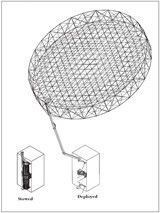
-
StatusCompleted
-
Status date2011-12-22
-
Activity Code1B.041
The study explored the possible benefit of advanced air interface techniques as well as advanced payload/ground segment solutions for providing more cost effective broadcast/interactive services in the near future.
Main emphasis was on validating the merits of the new promising solutions being proposed at that scope (e.g. MIMO, interference cancellation, on-ground beamforming, hybrid satellite /terrestrial coverage) with particular regard to a possible future application for an S-band mobile satellite systems.
The project fits within the evolving scenario of satellite systems designed to offer various types of services to mobile devices (such as phones, PDAs, vehicular terminals, etc.), for which there is a considerable interest in Europe as witnessed by the recent - though unfortunate - launch of the W2A satellite and by the S-band allocation to this type of service.
While the main emphasis has initially been on providing television broadcasting services to mobile users, there is now a clear interest for also expanding the service offer to advanced two-way interactive applications. In order to provide such kind of services in a cost effective manner, innovative techniques and technologies as well as advanced architectures for integrating satellite and terrestrial networks are required.
Accordingly, the subject study aimed at identifying and analysing efficient hybrid system architectures which, thanks to the availability of new techniques and technologies, is able to provide enhanced interactive & broadcast services to a mix of cheap mobile terminals.
Beyond the purely technical issues (such as air interface, payload & ground segment techniques, integration with terrestrial networks, hybrid networks management techniques & protocols, spectrum sharing, etc.), the subject study covered many other topics, noticeably the definition of service demands and the matching mission requirements, the quantitative assessment of the advantages provided by the proposed system architectures, and the identification of the key enabling technologies.
The following issues were specifically addressed in the project:
- Service Requirements for future S-band missions,
- Applicability and performance of MIMO techniques,
- Applicability and performance of Interference Alignment techniques,
- Algorithms for on-ground beamforming,
- Interference cancellation algorithms and their performances,
- Large Antenna Issues and payload issues in general,
- System performance with the different technical solutions proposed and relative trade-offs.
The project has contributed to the understanding of the potentiality of the satellite in serving the communication needs of people in the move. In particular, it has explored how to further push the limits of satellites in providing cost-effective broadcast and interactive services to the general population even in geographical regions like Europe where a terrestrial mobile communication infrastructure is relatively well developed.
The project has allowed to sort, between the proposed new technical solutions, those which have the greater impact on the system performance. The project output should be useful for technology-policy makers for better focusing their technology development roadmap on solutions having the larger benefit potential.
To evaluate the potentiality of next generation Interactive/Broadcast Mobile systems a technical approach was envisaged which, after having defined the key mission requirements for a future satellite system, has explored the applicability and potential benefits of the new air interface solutions being proposed in the technical literature for enhancing the performance of mobile communication systems.
The required ground and payload support for the new techniques was also investigated. The outcome of the first part of the project has lead to the definition of a couple of candidate systems.
The first candidate system is based on a single GEO satellite with a large on-board antenna (24 m. reflector, see view below):
A dual-polarization MIMO scheme was proposed for both the FL and RL air interfaces. Use of on-ground beamforming was also envisaged with the goal of improving the frequency reuse (up to full frequency reuse in the RL).
The second candidate solution explored a dual satellite scenario. A SW tool was developed in the project to allow full system simulations of the proposed techniques. The tool allows to model the overall satellite system (including the detailed antenna patterns) and the ground terminal population. This has permitted to get quantitative results about the achievable system capacity which in turn has allowed to quantify the benefits of the proposed solutions when compared to current conventional state-of-the-art satellite systems.
Use of dual-pol MIMO in particular has been shown to provide at least 50% capacity improvement (for the same on-board power) in the interactive FL with respect to SISO solutions. Even greater improvements can be get in the RL by exploiting dynamic on-ground beamforming.
The project was started in March 2010 and was completed by July 2011.
The project is completed.






